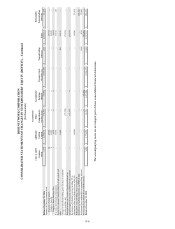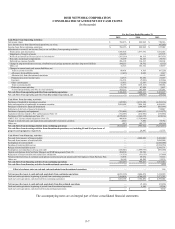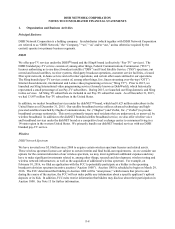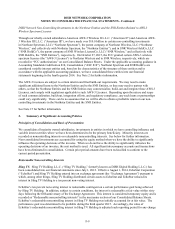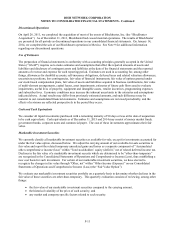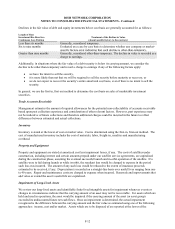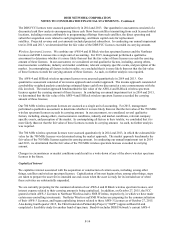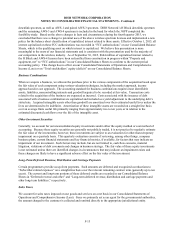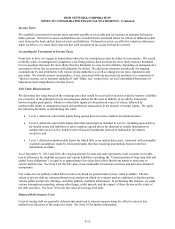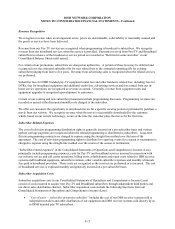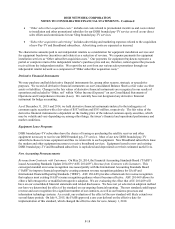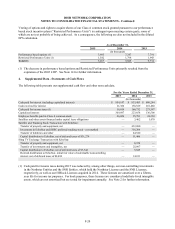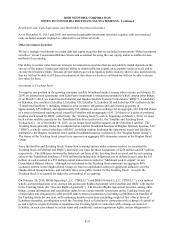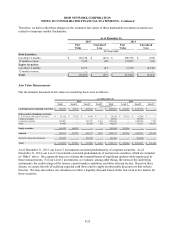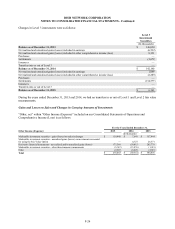Dish Network 2015 Annual Report Download - page 120
Download and view the complete annual report
Please find page 120 of the 2015 Dish Network annual report below. You can navigate through the pages in the report by either clicking on the pages listed below, or by using the keyword search tool below to find specific information within the annual report.DISH NETWORK CORPORATION
NOTES TO CONSOLIDATED FINANCIAL STATEMENTS - Continued
F-16
Income Taxes
We establish a provision for income taxes currently payable or receivable and for income tax amounts deferred to
future periods. Deferred tax assets and liabilities are recorded for the estimated future tax effects of differences that
exist between the book and tax basis of assets and liabilities. Deferred tax assets are offset by valuation allowances
when we believe it is more likely than not that such net deferred tax assets will not be realized.
Accounting for Uncertainty in Income Taxes
From time to time, we engage in transactions where the tax consequences may be subject to uncertainty. We record
a liability when, in management’s judgment, a tax filing position does not meet the more likely than not threshold.
For tax positions that meet the more likely than not threshold, we may record a liability depending on management’s
assessment of how the tax position will ultimately be settled. We adjust our estimates periodically for ongoing
examinations by and settlements with various taxing authorities, as well as changes in tax laws, regulations and
precedent. We classify interest and penalties, if any, associated with our uncertain tax positions as a component of
“Interest expense, net of amounts capitalized” and “Other, net,” respectively, on our Consolidated Statements of
Operations and Comprehensive Income (Loss).
Fair Value Measurements
We determine fair value based on the exchange price that would be received for an asset or paid to transfer a liability
(an exit price) in the principal or most advantageous market for the asset or liability in an orderly transaction
between market participants. Market or observable inputs are the preferred source of values, followed by
unobservable inputs or assumptions based on hypothetical transactions in the absence of market inputs. We apply
the following hierarchy in determining fair value:
x Level 1, defined as observable inputs being quoted prices in active markets for identical assets;
x Level 2, defined as observable inputs other than quoted prices included in Level 1, including quoted prices
for similar assets and liabilities in active markets; quoted prices for identical or similar instruments in
markets that are not active; and derivative financial instruments indexed to marketable investment
securities; and
x Level 3, defined as unobservable inputs for which little or no market data exists, consistent with reasonably
available assumptions made by other participants therefore requiring assumptions based on the best
information available.
As of December 31, 2015 and 2014, the carrying amount for cash and cash equivalents, trade accounts receivable
(net of allowance for doubtful accounts) and current liabilities (excluding the “Current portion of long-term debt and
capital lease obligations”) is equal to or approximates fair value due to their short-term nature or proximity to
current market rates. See Note 6 for the fair value of our marketable investment securities and derivative financial
instruments.
Fair values for our publicly traded debt securities are based on quoted market prices, when available. The fair
values of private debt are estimated based on an analysis in which we evaluate market conditions, related securities,
various public and private offerings, and other publicly available information. In performing this analysis, we make
various assumptions regarding, among other things, credit spreads, and the impact of these factors on the value of
the debt securities. See Note 10 for the fair value of our long-term debt.
Deferred Debt Issuance Costs
Costs of issuing debt are generally deferred and amortized to interest expense using the effective interest rate
method over the terms of the respective notes. See Note 10 for further information.


